Barn door tracker
Encyclopedia
A barn door tracker, also known as a Haig or Scotch mount, is a device used to cancel out the diurnal motion
of the Earth for the observation or photography
of astronomical object
s. It is a simple alternative to attaching a camera to a motorized equatorial mount
.
magazine in April 1975. Modified versions of the tracker were published in the magazine's February 1988 and June 2007 editions.
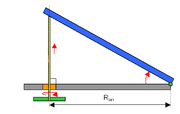 A simple single-arm barn door tracker can be made by attaching two pieces of wood together with a hinge. A camera
A simple single-arm barn door tracker can be made by attaching two pieces of wood together with a hinge. A camera
is mounted on the top board, usually with some sort of ball joint
to allow the camera to be pointed in any direction. The hinge is aligned with a celestial pole and the boards are then driven apart (or together) at a constant rate, usually by turning a threaded rod or bolt. This is called a tangent drive.
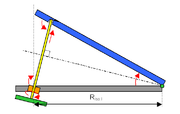 This type of mount is good for approximately 5–10 minutes before tracking errors become evident when using a 50 mm lens. This is due to the tangent error. That length of time can be increased to about 20 minutes when using an isosceles mount.
This type of mount is good for approximately 5–10 minutes before tracking errors become evident when using a 50 mm lens. This is due to the tangent error. That length of time can be increased to about 20 minutes when using an isosceles mount.
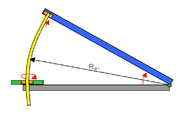 A curved drive bolt in lieu of either a straight tangent or isosceles mount will greatly extend the useful tracking time.
A curved drive bolt in lieu of either a straight tangent or isosceles mount will greatly extend the useful tracking time.
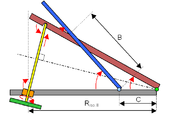 These designs were further improved upon by Dave Trott, whose designs were published in the February 1988 issue of Sky & Telescope. By using a second arm to drive the camera platform - thus adding complexity to the fabrication - tracking accuracy was greatly increased, and can lead to exposure times of up to one hour. The most accurate of these designs is the Type-4.
These designs were further improved upon by Dave Trott, whose designs were published in the February 1988 issue of Sky & Telescope. By using a second arm to drive the camera platform - thus adding complexity to the fabrication - tracking accuracy was greatly increased, and can lead to exposure times of up to one hour. The most accurate of these designs is the Type-4.
A modified double arm design minimizes tangent error by raising the point of rotation of the arm on which the camera is mounted. This has the effect of tilting the arc traced by the camera arm backwards causing it to follow a better path.
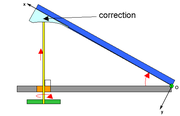 A basic geometrical analysis of the tangent error shows that it can be fully compensated for by inserting a special shaped piece between the threaded rod and the top board. Such solution was already known long time before the original G. Haig publication.
A basic geometrical analysis of the tangent error shows that it can be fully compensated for by inserting a special shaped piece between the threaded rod and the top board. Such solution was already known long time before the original G. Haig publication.
The most basic of these designs are manually operated, although some have added electric motor
s to automate and improve the accuracy of the tracking process.
Diurnal motion
Diurnal motion is an astronomical term referring to the apparent daily motion of stars around the Earth, or more precisely around the two celestial poles. It is caused by the Earth's rotation on its axis, so every star apparently moves on a circle, that is called the diurnal circle. The time for...
of the Earth for the observation or photography
Photography
Photography is the art, science and practice of creating durable images by recording light or other electromagnetic radiation, either electronically by means of an image sensor or chemically by means of a light-sensitive material such as photographic film...
of astronomical object
Astronomical object
Astronomical objects or celestial objects are naturally occurring physical entities, associations or structures that current science has demonstrated to exist in the observable universe. The term astronomical object is sometimes used interchangeably with astronomical body...
s. It is a simple alternative to attaching a camera to a motorized equatorial mount
Equatorial mount
An equatorial mount is a mount for instruments that follows the rotation of the sky by having one rotational axis parallel to the Earth's axis of rotation. This type of mount is used for astronomical telescopes and cameras...
.
History
The barn door tracker was created by George Haig. His plans were first published in Sky & TelescopeSky & Telescope
Sky & Telescope is a monthly American magazine covering all aspects of amateur astronomy, including the following:*current events in astronomy and space exploration;*events in the amateur astronomy community;...
magazine in April 1975. Modified versions of the tracker were published in the magazine's February 1988 and June 2007 editions.
Principle

Camera
A camera is a device that records and stores images. These images may be still photographs or moving images such as videos or movies. The term camera comes from the camera obscura , an early mechanism for projecting images...
is mounted on the top board, usually with some sort of ball joint
Ball joint
In an automobile, ball joints are spherical bearings that connect the control arms to the steering knuckles.More specifically, a ball joint is a steel bearing stud and socket enclosed in a steel casing. The bearing stud is tapered and threaded. It fits into a tapered hole in the steering knuckle. A...
to allow the camera to be pointed in any direction. The hinge is aligned with a celestial pole and the boards are then driven apart (or together) at a constant rate, usually by turning a threaded rod or bolt. This is called a tangent drive.



A modified double arm design minimizes tangent error by raising the point of rotation of the arm on which the camera is mounted. This has the effect of tilting the arc traced by the camera arm backwards causing it to follow a better path.

The most basic of these designs are manually operated, although some have added electric motor
Electric motor
An electric motor converts electrical energy into mechanical energy.Most electric motors operate through the interaction of magnetic fields and current-carrying conductors to generate force...
s to automate and improve the accuracy of the tracking process.
External links
- Trott, David. The Double Arm Barn Door Drive
- DeTray, Jeff. Build a Barn Door Tracker
- Gagnon, Steve. How to build a double-arm barn door tracker
- Michaud, Frederic. An error free Scotch mount
- Peters, W. The Cosmic Canvas
- Tonkin, Stephen. A Better Barn door
- Cheshire, Rowland. http://synergous.com/flatpress/?x=entry:entry111127-004915

